Beth Kanell's Blog, page 12
March 28, 2020
It's All About Exposure (to What?)
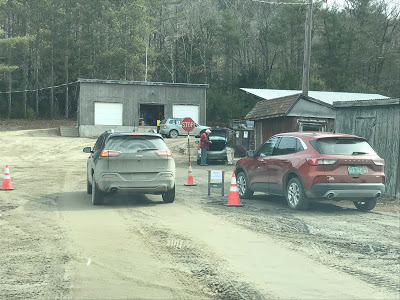
I went grocery shopping this morning.
Context: The Covid-19 pandemic has not yet peaked here in northern New England, but we have reached the point where it's personal -- I know a family that's battling the infection, and they live about 10 miles from my place. At least two in our nearest shopping town have tested positive.
So I made a mask from a pleated paper towel and rubber bands and staples (thank you, Internet), added a pair of reading glasses for eye protection and nitrile gloves left from nursing my husband last year, and headed to a town where there's a friendly "food cooperative."
On the way, I stopped at the transfer station (what we used to call the dump), to drop off a bag of roadside trash. (Farming keeps Vermont green; picking litter up helps you be able to SEE the green, without cringing.) And things had changed. A lot.
"The dump" is where many of us count on a few minutes of old-fashioned socializing. Retired men in hunting jackets or ball caps exchange news. Fussy individuals drop their recycling into the correct bins and pull out the mistakes made by less fussy ones. Town trucks are parked nearby, at the town garage and the fire station.
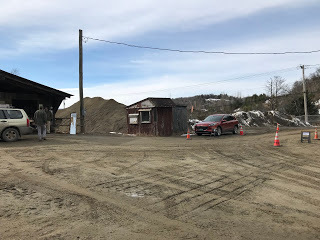
And everybody smiles and says "how's it going" and "what a day!" and "I hate to let go of this old lamp but we're moving, know anyone who might want it?" Sometimes the school kids collect redeemable cans and bottles to fund end-of-term trips. Once in a while there's a lost dog poster.
Today: A stop sign. Directions to form a single lane. "Social distancing," one vehicle at a time, for those bringing bags of trash to the big compactor. And the young man watching over the recycling shed wore a bright green mask over his mouth and nose.
When I'd delivered my blue bag to the compactor, an older man in charge, with bristling winter beard and mustache, exchanged smiles with me from a safe dozen feet away. He called out, not "stay warm" or "keep out of trouble" (to which one may either grin wickedly and say "who me?" or nod and say "will do"), but "Stay safe!"
Things change.
Then I drove more back roads toward the food cooperative, and along the way I passed a few couples walking along the edge of the road. Eager to add a little cheering up to the usual "I see you" wave that a polite driver offers around here, I waggled my brightly gloved hand and beamed a big smile at each.
One couple didn't even look. The other pointedly gazed the other way.
I want to guess they were among the folks who mostly live out of state and have come to their "summer place" in Vermont this month, seeking safety from the virus, seeking a place where they won't be exposed to how tough life can be, and how scary it is to be ill. I want to be kind and tolerant, and not picture how they'll react if they "have to" call for emergency services, which around here are often staffed with highly trained, compassionate volunteers as well as EMTs. I want to call "Stay safe!" out the car window.
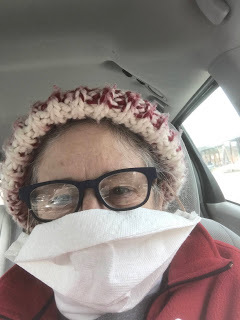 But those folks are more than a little lost, "sheltering in place" in a Vermont that's hardly what they expect: no green grass yet, no pretty gardens, no festivals. It's March, it's mud season, and it's pandemic season.
But those folks are more than a little lost, "sheltering in place" in a Vermont that's hardly what they expect: no green grass yet, no pretty gardens, no festivals. It's March, it's mud season, and it's pandemic season.Besides, they haven't had much exposure yet to how we all depend on each other and come through for each other up here. And I don't want to scare anyone. So I park at the food cooperative, pull my paper-towel mask into position, and wish I'd drawn the smile onto it that I pictured this morning. Nope, on second thought, next time I go shopping, I'll take a red crayon and write words on my mask. "Stay safe! And keep out of trouble. Smile!"
Published on March 28, 2020 09:56
March 19, 2020
It's Been Almost a Year Since -- Well, I Love Him Always
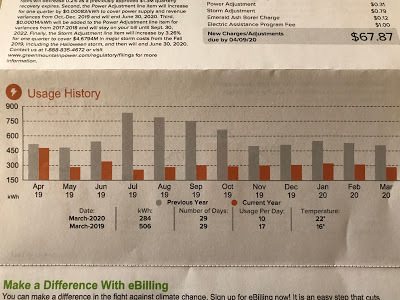 There isn't a way to measure mourning, the long process of missing someone vital, important to your heart. At least, for me there isn't. And with each day closer to March 23 -- the Jewish calendar 1-year mark since Dave's death -- and to April 3, the calendar date last year when the husband I adored gave his last breath, I become more of a spashing sea of saltwater. Be careful, this week I weep or holler at the drop of an emotional moment, and I don't expect to "get over" it. But on April 4, I promise to take a deep breath and focus on what's ahead more than on what's unreachable to hands and lips.
There isn't a way to measure mourning, the long process of missing someone vital, important to your heart. At least, for me there isn't. And with each day closer to March 23 -- the Jewish calendar 1-year mark since Dave's death -- and to April 3, the calendar date last year when the husband I adored gave his last breath, I become more of a spashing sea of saltwater. Be careful, this week I weep or holler at the drop of an emotional moment, and I don't expect to "get over" it. But on April 4, I promise to take a deep breath and focus on what's ahead more than on what's unreachable to hands and lips.Just for perspective, here's the electric company's graph of how the year has gone. No dueling TVs drawing power as Dave keeps tabs on the 24/7 news cycle. No air conditioning. One person's lighting use, minimized as much as possible. Still bread being baked, but far less laundry to wash and dry.
So here's my wish/prayer/petition of the day: Let me take all that "saved energy" and all Dave's love that I know is still with me, and infuse it into some darned good writing coming up. To life. L'chaim.
Published on March 19, 2020 08:16
March 17, 2020
Irish Soda Bread, and Some Vermont Irish History
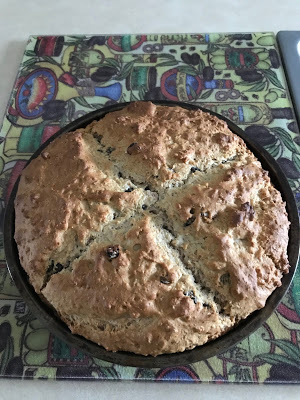 The best of St. Patrick's Day to you! And may your luck be cheerful and in all the right directions on this fine March day.
The best of St. Patrick's Day to you! And may your luck be cheerful and in all the right directions on this fine March day.It's a day that I like to celebrate by making Irish soda bread, and this year, just for the fun of it, I tried out the whole-grain boxed mix provided by King Arthur Flour, one of our Vermont-focused businesses. Very tasty, and it didn't cut much into my work time this way!
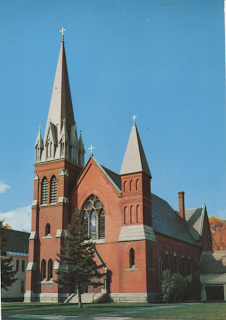
It's a good moment to remember that being Irish once meant a great deal in St. Johnsbury, Vermont. Just a few decades ago, the town's residents in response to the Census notched up 30% with Irish heritage. Significant in the area was the presence for decades of two Catholic churches: one "French" (mostly French Canadian, with Mass provided in both Latin and French), and "Irish" (Mass in Latin and English). The "Irish" church was St. Aloysius, pictured here; after the "French" church, Notre Dame des Victories, burned (yes, arson), the congregations merged and renamed the new church group St. John the Evangelist. Here's the building, from one of my late husband Dave Kanell's postcards.
The most recent available Census data, from the 2017 American Community Survey (the newer name for this batch of Census detail), showed 10.1% of Americans mentioning Irish heritage; 17.3% of Vermont residents; and 14.4% of those responding in Caledonia County (where another 14.4 percent mentioned French, 11.1% French Canadian -- should we add those together? -- and 18.2% English heritage; yes, Scottish comes in at 5.9%, and Italian at 5.5%). That's about one-seventh of the county with Irish heritage!
When I visit my New York City grandsons, I like to step across to their neighborhood's amazing Irish Hunger Memorial. Here are two photos of the structure, taken by Wally Gobetz and shared on flickr (thank you!); there's a description of the memorial added below, and if you don't have time to read it all, just keep this in mind: It's built from an actual stone cottage from Ireland, like the ones people lived in at the time of the potato famine there. I imagine the mud and stone and starvation made these homes feel terribly, frighteningly cold.
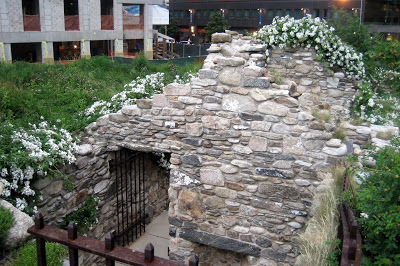

In fact, we have some great descriptions of exactly that, from Asenath Hatch Nicholson, a woman originally from Chelsea, Vermont, who left what comfort she'd found in New York City to go and see the starvation conditions for herself back in 1844. See my earlier discussion of her work here.
Now, before I go spread some good Vermont-branded butter on my next chunk of Irish soda bread, one more important history item: The first to use "baking soda" in bread recipes were not the Irish, but Native Americans, says noted food writer Gillie Houston -- see her explanation here -- and the recipe drifted to Ireland, as that region adopted agriculture and recipes for locally grown "soft" wheat.
You just never know what you'll come across, when you start digging into history. Or baking!
***
[memorial explanation originally published at https://www.atlasobscura.com/places/i...]
A winding path is lined with blackthorn, foxglove, and ling heather, marked with 32 rocks each engraved with the name of an Irish county. The quarter-acre of Ireland on the edge of Manhattan is a memorial to the over one million Irish who died during the Great Famine of the 1840s, as well as those who continue to suffer from hunger.
Designed by artist Brian Tolle, the Irish Hunger Memorial in Battery Park incorporates a Famine-era stone cottage brought over from County Mayo, Ireland, and reconstructed as the heart of the monument. Visitors can enter directly from the street up a path through the suspended field, or through a tunnel lined with granite and words behind glass remembering worldwide hunger crises, while a ghostly recording plays voices recounting famine.
Room has been left for more words to mark new hunger crises. From the top of the field at 25 feet in the air, there is a view of the Statue of Liberty and Ellis Island, the first stop for many of the over two million Irish immigrants to the United States.
Published on March 17, 2020 07:18
March 12, 2020
Bats in My Belfry
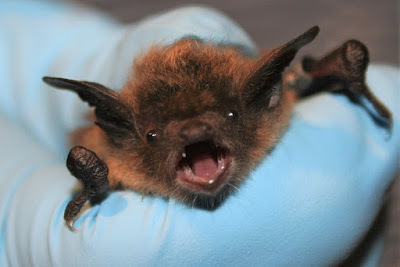 Little brown bat, photo from Wikimedia Commons, by Enwebb.Today's research, for both a history article and a set of poems, took me from the wooded summit of Burke Mountain in northeastern Vermont, to reading of cave explorations in China. I was fascinated to follow the interview with the "bat woman" in Wuhan,* and concerned for the future of her career. And I spent time looking at bat faces and remembering the first bat that I saw up close. It's a dreadful memory.
Little brown bat, photo from Wikimedia Commons, by Enwebb.Today's research, for both a history article and a set of poems, took me from the wooded summit of Burke Mountain in northeastern Vermont, to reading of cave explorations in China. I was fascinated to follow the interview with the "bat woman" in Wuhan,* and concerned for the future of her career. And I spent time looking at bat faces and remembering the first bat that I saw up close. It's a dreadful memory.I was eleven years old, a sheltered suburban child, oldest of five and used to responsibility for the other kids ("You're the oldest, you're supposed to keep an eye on them!"). Incredibly, because my mother knew the camp director, I had been signed up for three weeks at a girls' camp out in the green forested part of New Jersey, among quiet mountains and clear blue lakes. If I'd known more of what would take place—archery lessons, modern dance, first taste of musical theater, the mystic power of singing around a campfire—I wouldn't have understood any of it. Facing the three weeks, the notion of swimming lessons (I hated getting my face wet) and sleeping away from home (I'd never been away from Mom for more than a few hours) terrified me. My mother, ignoring the emotions, made lists, stitched nametags into T-shirts, counted off stamps for me to write to her. And dropped me off with nearly a hundred people I'd never met, and one that I had: the camp director. Call her Lee.
The fifth night? Maybe. Supper in the dining hall, songs at the tables, some evening activity that kept us out among the stars and fireflies. I followed my cabin mates back, aware now of each one's name but still uncertain whether any of them liked me. A scream erupted from the first stacked bunks where a girl named Carol slept on the bottom bed, her best friend Michelle above her. It was Michelle screaming, waving her arms toward the ceiling. "A bat! A bat!"
Three counselors told us to each grab a sweatshirt, pull our hoods up over our hair, wait out on the porch. Armed with brooms, they struggled to shoo the flying mammal out the door, but it kept going back up into the eaves. Finally one counselor struck it with her broom and, stunned, the little winged body tumbled to the floor. Someone wrapped it in a towel. Ugh.
Who summoned the director? I don't know. But she brought a large lidded jar with her, maybe a gallon size, and deftly dumped the bat into it. And vanished into the night.
I woke early the next morning and, newly curious, trotted down the slope to the back porch of the director's house. I saw her sitting there, and called out, "What did you do with the bat?"
"I'll show you, if you want," she offered, eyeing me sideways.
What else could I say? "Yes, please. I want to see."
She fetched the jar, where she'd punched holes in the lid. That seemed familiar to me—at home, we also punched holes in jar lids when we held fireflies overnight, admiring their flashing.
But the grotesque furry face with its exposed needle-shaped teeth made me shudder, and the wings, cramped inside the jars, looked leathery and ugly. I asked, "What will you do with it?" I suppose I was thinking it would get released someplace else, away from the camp.
"Watch," the director replied. She took the jarred animal to one of the big sinks we used for cleaning up after crafts (already one of my less successful areas of learning), and turned on the water. Placing the jar under the tap, she let the water stream into it through the holes in the lid.
I only managed to watch until the jar reached about three-quarters full of water, the winged animal inside drowning in the process.
Maybe I said something. I can't recall now. But I remember running, running, and finding my cabin empty, and racing to the dining hall, late to join the others at the long table, gasping, unvoiced.
Now that I look back, I'm amazed I finished the three weeks. And I sing the camp songs. Sang them to hush my first and second babies when they were colicky and I sat in the rocking chair for hours, struggling to stay away enough to keep rubbing the arch of the warm little baby's back, waiting for a burp or a long fart and relief. I don't believe I thought about the bat, as I sang.
But now, as the virus from Wuhan spreads across the globe, and my grandson has suddenly reached the age when I went to camp ... I remember. May he never see a bat killed that way, even in this frightening pandemic. May his fears be small ones, easily comforted. May they be shared.
* https://www.scientificamerican.com/article/how-chinas-bat-woman-hunted-down-viruses-from-sars-to-the-new-coronavirus1/
Published on March 12, 2020 10:14
March 5, 2020
Publication date for THIS ARDENT FLAME (Winds of Freedom Book 2)
 Five Star/Cengage tells me that as of now, the publication date for THIS ARDENT FLAME is December 16, 2020.
Five Star/Cengage tells me that as of now, the publication date for THIS ARDENT FLAME is December 16, 2020.Let's figure out how best to celebrate the book in Vermont, so everyone who wants copies for holiday gifts and holiday reading will be able to get them!
And the next big step will be the cover design, so ... watch for it!
More news on other topics, tomorrow.
PS: A taste of Chapter 1:
North Upton, Vermont, October 1852<!-- /* Font Definitions */ @font-face {font-family:"MS Mincho"; panose-1:2 2 6 9 4 2 5 8 3 4; mso-font-alt:"MS 明朝"; mso-font-charset:128; mso-generic-font-family:roman; mso-font-pitch:fixed; mso-font-signature:1 134676480 16 0 131072 0;} @font-face {font-family:"Cambria Math"; panose-1:2 4 5 3 5 4 6 3 2 4; mso-font-charset:0; mso-generic-font-family:roman; mso-font-pitch:variable; mso-font-signature:-536870145 1107305727 0 0 415 0;} @font-face {font-family:"\@MS Mincho"; panose-1:2 2 6 9 4 2 5 8 3 4; mso-font-charset:128; mso-generic-font-family:modern; mso-font-pitch:fixed; mso-font-signature:-536870145 1791491579 134217746 0 131231 0;} /* Style Definitions */ p.MsoNormal, li.MsoNormal, div.MsoNormal {mso-style-unhide:no; mso-style-qformat:yes; mso-style-parent:""; margin:0in; margin-bottom:.0001pt; mso-pagination:widow-orphan; font-size:12.0pt; font-family:"Times New Roman",serif; mso-fareast-font-family:"MS Mincho"; mso-fareast-theme-font:minor-fareast;} .MsoChpDefault {mso-style-type:export-only; mso-default-props:yes; font-size:10.0pt; mso-ansi-font-size:10.0pt; mso-bidi-font-size:10.0pt; mso-fareast-font-family:"MS Mincho"; mso-fareast-theme-font:minor-fareast; mso-fareast-language:JA;}size:8.5in 11.0in; margin:1.0in 1.0in 1.0in 1.0in; mso-header-margin:.5in; mso-footer-margin:.5in; mso-paper-source:0;} div.WordSection1 {page:WordSection1;}</style>
Chapter 1A cold wind off the ridge followed me as I trudged down the worn path, the pack basket of late apples heavy against my back. Dark clouds scudded from the west. When the first small raindrops struck my cheek, I tried to tug my woolen shawl forward, to keep my dark hair dry. But the weight of the apples and their off-balance shift in the pack meant I needed to grip the shoulder straps with both hands, so I couldn’t arrange the shawl any better. “Drat. Drat, again.” Had I spoken aloud? Well, nobody would hear my unladylike words. Cutting down through the field from my brother William’s home, toward the center of the village, wasn’t exactly ladylike, either. Pfui. Since I’d been a little girl, I’d taken this track. Of course, back then, the house beyond the mill belonged to my father’s older brother, Uncle Owen. Jerushah, my best friend, used to walk with me to visit Uncle Owen and Aunt Lina. Jerushah. I shivered.
Published on March 05, 2020 07:48
December 25, 2019
Because Shadows Are Part of Life
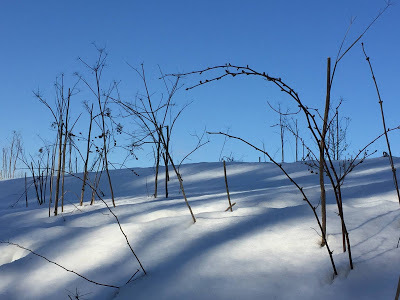 It's been eight and a half months since my husband (= soulmate) died, and every day brings new ways to feel and learn. One important lesson has been to grasp the difference between grief -- which is a reaction to the loss itself -- and mourning, which has more to do with learning to live with an absence.
It's been eight and a half months since my husband (= soulmate) died, and every day brings new ways to feel and learn. One important lesson has been to grasp the difference between grief -- which is a reaction to the loss itself -- and mourning, which has more to do with learning to live with an absence.Recently a friend and I were discussing the Book of Job, a part of the scriptures (or haftorah in Jewish tradition) that can make people very uncomfortable, because the main speaker in it, Job, has an argument with G-d that seems to leave him at a terrible disadvantage, without any just cause for it. This poem reflects on that ... and takes its title, "The Storehouses of Snow," from the ancient text. And, PS, the photo is from a earlier winter; our snow is not that deep at the moment, but check back with my photos on Facebook when Friday's storm is done!
The Storehouses of Snow
First winter alone in the house on the ridge, wheremornings open gray and silver — when I follow the tracks
(deer, fox, squirrel, a flock of turkeys) and search the treesthere’s more blue sky than I first realized, flaming and yearning
oh how long, how deep does love root itself in the heart—it aches to touch, to clutch the answers. But:
There’s a thing about blue sky. Sometimes I don’t realizetil the moment I lift the camera to the bare branches above,
backdrop of tenderness with sparkles; silken, with cloud streakslook! without calling, two bluejays erupt and take wing.
Paired, they do not leave this place in winter. Nor do I.
Empty rooms echo, while the kettle hums, yesthe kitchen’s almost a safety zone, a place to make and taste
and the stacked dishes waiting to be washed proclaim“life is messy; choose life; go on, try it, try it, try it”
wet-handed (soaped) I dry it. The dish. My cheek. Salt wet.
Beware the living-room couch, with its loose comfort blowsy, ample, cushioned. Take a corner seat. Did you
bring a book? This program with the sound muted nowwas one he liked. We had a little race to be the first to say
“re-run!” and be correct. Sometimes people die and it’s notsomething you can prevent. Love can’t hold it back, although
my niece is worried that I seem sad. When she called, I was sittingby a window as the evening ripened: snow in the forecast.
Shadows on snow are blue but sometimes purple; some pinkin surprising places. The storehouses of snow must be designed
like the bold striped houses of the Gaspé, blooming plum and orangeabove winter’s etched certainties. Imagine the winter breath of G-d
throat cleared with a rattling cough, pillars of ice rising.
Grief is a clawed animal known to prehistoric soulsdigging like a sabre-toothed cat or dire wolf
tearing the flesh; opening the chest; releasing the arc of bonesdetermined to delve to the heart. Wrenching apart fiber
piercing each wanton cell with chemical injections of painerupting in coarse sobs, in wracked wailing, in screams. And then:
nights alone. Salt rivers. Oceans of separation.
How strange the new sun of mourning; fire from the lensas light flares from a disk of ice. Words that set sparks
paper smoking within a golden circle. Fingers that curvearound a mug of comfort. Yet not so fast! Rage, rage first,
rage against the jaws of death, against hunger and want, againsthalf-empty bed, against table for one. Rage, I say! G-d shouts.
Raw throat, scrubbed face, tumble of blame and rough words.
The saw blade rasps in the ash branch; scrapes past bark, wrestlesfiber and core, pinches under the arched arm. Prunes back rash hope
assaults the life force, demands a rush of sap from the rootsswelling, rising, dripping (sweet not salt) down the gray bark.
Let the storehouses of snow be opened. Blow, winter rages. Blowand rant and make the mountains kneel. Remind me how fierce
is love itself; how clawed; how it bites until the lips intervenethe tongue turns loose and hands grasp. How the calendar
numbers the days of the season. Insists (shouting, roaring)on April. On yellow, gold, and green. Which are not (except at sunrise)
present in the shadows on the snow.
-- BK
<!-- /* Font Definitions */ @font-face {font-family:"MS Mincho"; panose-1:2 2 6 9 4 2 5 8 3 4; mso-font-alt:"MS 明朝"; mso-font-charset:128; mso-generic-font-family:modern; mso-font-pitch:fixed; mso-font-signature:-536870145 1791491579 134217746 0 131231 0;} @font-face {font-family:"Cambria Math"; panose-1:2 4 5 3 5 4 6 3 2 4; mso-font-charset:0; mso-generic-font-family:roman; mso-font-pitch:variable; mso-font-signature:-536869121 1107305727 33554432 0 415 0;} @font-face {font-family:"\@MS Mincho"; panose-1:2 2 6 9 4 2 5 8 3 4; mso-font-charset:128; mso-generic-font-family:modern; mso-font-pitch:fixed; mso-font-signature:-536870145 1791491579 134217746 0 131231 0;} /* Style Definitions */ p.MsoNormal, li.MsoNormal, div.MsoNormal {mso-style-unhide:no; mso-style-qformat:yes; mso-style-parent:""; margin:0in; margin-bottom:.0001pt; mso-pagination:widow-orphan; font-size:12.0pt; font-family:"Times New Roman",serif; mso-fareast-font-family:"MS Mincho"; mso-fareast-theme-font:minor-fareast;} .MsoChpDefault {mso-style-type:export-only; mso-default-props:yes; font-size:10.0pt; mso-ansi-font-size:10.0pt; mso-bidi-font-size:10.0pt; mso-fareast-font-family:"MS Mincho"; mso-fareast-theme-font:minor-fareast; mso-fareast-language:JA;} @page WordSection1 {size:8.5in 11.0in; margin:1.0in 1.25in 1.0in 1.25in; mso-header-margin:.5in; mso-footer-margin:.5in; mso-paper-source:0;} div.WordSection1 {page:WordSection1;} </style> --><br /><span class="_5yl5"></span>
Published on December 25, 2019 12:45
October 20, 2019
Maternity Homes in Vermont: A Research Story (and Invitation!)
Vermont “Maternity Homes”[originally published in Vermont Views (VV) Magazine]by Beth Kanell
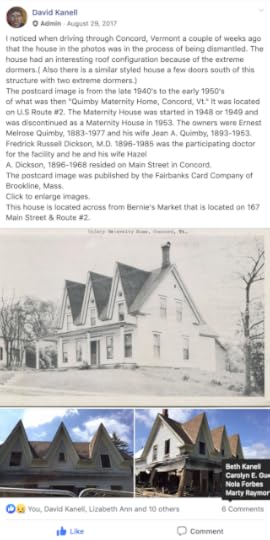 It began with a postcard. My husband Dave (who passed last April) collected them: colorful Vermont scenes, yes, but more importantly the black-and-white ones from the late 1800s and early to mid 1900s that showed actual scenes, especially in the Northeast Kingdom. There are hundreds of St. Johnsbury and Lyndonville images in his collection—but, proportional to both town size and events that seemed worth marketing as photographs, there are very few from, say, Granby or Victory in Essex County. Or from Concord. Dave plunged me into a new research project when he found a card labeled “Quimby Maternity Home, Concord, Vt.” His knowledge of postcard publishers and some quick investigation prompted him to added the information “1949–1953.” As we, and then I, probed further, we found more than 50 documented births that took place, not just in the Quimby (also called Graves, for nurse Ardella “Nana” Graves) Maternity home, but also in the Austin Maternity Home in the same small town (this one, run by Leah Virginia Austin). And both were clearly “supervised” by the local doctor, Frederick Russell Dickson, M.D. “Maternity homes” in the rest of America seem to have often been places for unwed mothers to give birth and send their babies out for adoption. Dave and I found a single request from an adoptee born in 1946 at a Concord maternity home for clues to his parentage. But that turned out to be the exception. Online access led us to birth certificates of many babies simply born in these more supportive, medically encouraged “homes.” Mothers could arrive a day early, stay a few days afterward, have a break from parenting and get a good start with the new arrival. But such maternity homes were not well documented. In the case of the ones in Concord, Dr. Dickson worked under contract for the local paper mill, which provided him space for a “dispensary,” and cared for many more illnesses, injuries, and preventive cases than the babies being born—and no records from the two maternity homes have been located. So Dave and I went to local Facebook “pages” and “groups,” where residents current and past share their memories. To our astonishment, we discovered another maternity home that took patients at the same time period, the early 1900s, and it was about 20 miles from Concord, in Lyndonville, Vermont. Then word of a second Lyndonville maternity home came, with oral confirmation that it had started in Burke and relocated. This is how a small postcard research project begins to spin outward! The community of local history researchers is compact and supportive. This summer and fall, I began writing to others in other towns, to see whether the maternity homes of this part of the Northeast Kingdom were an isolated phenomenon or part of something wider. After several negatives, I heard from local historian Joan Alexander of Glover, who passed along work by Darlene Young in her “A History of Barton, Vermont” (1998). Young outlined Barton’s medical providers in the late 1800s and mentioned Dr. Percy Buck, born in Charleston, Vermont. Dr. Buck arrived in Glover in 1914, and in 1935 moved to Barton. Young wrote, “During his career, he delivered over 2,000 babies, many of them at the Cottage Hospital.” I hope your reading “ears” just perked up the way mine did. Eagerly, I discovered from Young’s account that the double factors of the 1918 “Spanish” influenza outbreak and the changes in World War I era medicine resulted in nurse Harriet Austin in 1913 working in Baron at the “Sunshine Sanitorium,” which Young said “served a number of functions, providing both professional nursing care as well as a suitable place to handle surgical procedures. Increasingly, the sanitorium attracted maternity patients as well.” Then in 1923 a new medical graduate in Barton, Dr. Elwin M. Nichols, purchase a large home “with plans to establish his own hospital,” Young wrote. “He hoped to provide patients with both a comfortable, homey atmosphere and state-of-the-art medical equipment.” Soon the Nichols Hospital took over for the late 1920s. When Dr. Nichols yielded to his own medical problems, nurse Bernice Atwell opened the Cottage Hospital in Barton. Her particular focus was on maternity patients. Young noted its advantages over home delivery, including sanitary conditions, modern equipment, and rest for the patients. The percent of births held there increased steadily, drawing from as far away at Coventry and Craftsbury. Around 1950, however, trends shifted, and in 1954 Atwell, then aged 65 herself, closed her little hospital. Cottage Hospital! I darted to records of the historic Cottage Hospital in Woodsville, New Hampshire, across the river from Wells River, Vermont. It began in 1903, in a building that dated back to 1795, when it was the Cobleigh Tavern. Then it yielded to a “modern” and larger hospital opened in 1960. Now the tiny maternity home trend of the Northeast Kingdom had merged into a statewide trend, for I found another Cottage Hospital at the opposite end of the state, Grace Cottage Hospital in Townshend, Vermont. Its timeline differed a bit, but it clearly belonged. It’s surprising to realize that even in medicine, which relies so much on records, the phenomenon of maternity and birth has been relatively unrecorded. I hope this research will trigger more—in the footsteps of midwife Lydia Baldwin of Bradford, Vermont, whose records are represented at Dartmouth College today: 926 births from 1768 to 1819, of which only 2.9 percent were stillbirths, despite the challenges of conditions and knowledge. Know more about maternity homes in your area? I hope you’ll share the knowledge!
It began with a postcard. My husband Dave (who passed last April) collected them: colorful Vermont scenes, yes, but more importantly the black-and-white ones from the late 1800s and early to mid 1900s that showed actual scenes, especially in the Northeast Kingdom. There are hundreds of St. Johnsbury and Lyndonville images in his collection—but, proportional to both town size and events that seemed worth marketing as photographs, there are very few from, say, Granby or Victory in Essex County. Or from Concord. Dave plunged me into a new research project when he found a card labeled “Quimby Maternity Home, Concord, Vt.” His knowledge of postcard publishers and some quick investigation prompted him to added the information “1949–1953.” As we, and then I, probed further, we found more than 50 documented births that took place, not just in the Quimby (also called Graves, for nurse Ardella “Nana” Graves) Maternity home, but also in the Austin Maternity Home in the same small town (this one, run by Leah Virginia Austin). And both were clearly “supervised” by the local doctor, Frederick Russell Dickson, M.D. “Maternity homes” in the rest of America seem to have often been places for unwed mothers to give birth and send their babies out for adoption. Dave and I found a single request from an adoptee born in 1946 at a Concord maternity home for clues to his parentage. But that turned out to be the exception. Online access led us to birth certificates of many babies simply born in these more supportive, medically encouraged “homes.” Mothers could arrive a day early, stay a few days afterward, have a break from parenting and get a good start with the new arrival. But such maternity homes were not well documented. In the case of the ones in Concord, Dr. Dickson worked under contract for the local paper mill, which provided him space for a “dispensary,” and cared for many more illnesses, injuries, and preventive cases than the babies being born—and no records from the two maternity homes have been located. So Dave and I went to local Facebook “pages” and “groups,” where residents current and past share their memories. To our astonishment, we discovered another maternity home that took patients at the same time period, the early 1900s, and it was about 20 miles from Concord, in Lyndonville, Vermont. Then word of a second Lyndonville maternity home came, with oral confirmation that it had started in Burke and relocated. This is how a small postcard research project begins to spin outward! The community of local history researchers is compact and supportive. This summer and fall, I began writing to others in other towns, to see whether the maternity homes of this part of the Northeast Kingdom were an isolated phenomenon or part of something wider. After several negatives, I heard from local historian Joan Alexander of Glover, who passed along work by Darlene Young in her “A History of Barton, Vermont” (1998). Young outlined Barton’s medical providers in the late 1800s and mentioned Dr. Percy Buck, born in Charleston, Vermont. Dr. Buck arrived in Glover in 1914, and in 1935 moved to Barton. Young wrote, “During his career, he delivered over 2,000 babies, many of them at the Cottage Hospital.” I hope your reading “ears” just perked up the way mine did. Eagerly, I discovered from Young’s account that the double factors of the 1918 “Spanish” influenza outbreak and the changes in World War I era medicine resulted in nurse Harriet Austin in 1913 working in Baron at the “Sunshine Sanitorium,” which Young said “served a number of functions, providing both professional nursing care as well as a suitable place to handle surgical procedures. Increasingly, the sanitorium attracted maternity patients as well.” Then in 1923 a new medical graduate in Barton, Dr. Elwin M. Nichols, purchase a large home “with plans to establish his own hospital,” Young wrote. “He hoped to provide patients with both a comfortable, homey atmosphere and state-of-the-art medical equipment.” Soon the Nichols Hospital took over for the late 1920s. When Dr. Nichols yielded to his own medical problems, nurse Bernice Atwell opened the Cottage Hospital in Barton. Her particular focus was on maternity patients. Young noted its advantages over home delivery, including sanitary conditions, modern equipment, and rest for the patients. The percent of births held there increased steadily, drawing from as far away at Coventry and Craftsbury. Around 1950, however, trends shifted, and in 1954 Atwell, then aged 65 herself, closed her little hospital. Cottage Hospital! I darted to records of the historic Cottage Hospital in Woodsville, New Hampshire, across the river from Wells River, Vermont. It began in 1903, in a building that dated back to 1795, when it was the Cobleigh Tavern. Then it yielded to a “modern” and larger hospital opened in 1960. Now the tiny maternity home trend of the Northeast Kingdom had merged into a statewide trend, for I found another Cottage Hospital at the opposite end of the state, Grace Cottage Hospital in Townshend, Vermont. Its timeline differed a bit, but it clearly belonged. It’s surprising to realize that even in medicine, which relies so much on records, the phenomenon of maternity and birth has been relatively unrecorded. I hope this research will trigger more—in the footsteps of midwife Lydia Baldwin of Bradford, Vermont, whose records are represented at Dartmouth College today: 926 births from 1768 to 1819, of which only 2.9 percent were stillbirths, despite the challenges of conditions and knowledge. Know more about maternity homes in your area? I hope you’ll share the knowledge!CAPTIONS:The Facebook piece that Dave Kanell posted, which launched our grass-roots research into how maternity homes functioned in the Northeast Kingdom.
Mrs. Ardella (“Nana”) Graves, who ran one of the Concord, Vermont, maternity homes. Photo from the Facebook feed of the Concord Historical Society.
Published on October 20, 2019 07:22
October 13, 2019
Vermont Begins to Honor Indigenous Peoples' Day, 2019
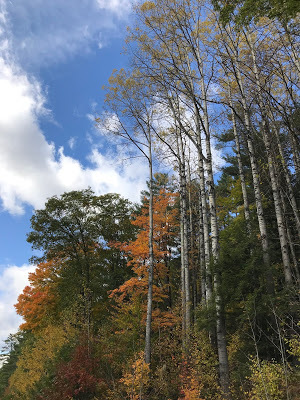 It is with great relief and some pride that I note that Vermont no longer has to depend on governors' declarations for each year's Indigenous Peoples' Day; beginning tomorrow, Monday October 14, the Green Mountain State honors its original residents and the continued presence of Abenaki/Wabenaki peoples with an official holiday.
It is with great relief and some pride that I note that Vermont no longer has to depend on governors' declarations for each year's Indigenous Peoples' Day; beginning tomorrow, Monday October 14, the Green Mountain State honors its original residents and the continued presence of Abenaki/Wabenaki peoples with an official holiday.That this happens during a time when almost all the traditional history guideposts are in flux is no surprise. We now know and understand more about the slaveholding positions of George Washington, Thomas Jefferson, and other founders of the nation. (I find some of the powerful art of Titus Kaphar remarkable in his vision of this.) We can finally look back and acknowledge that the verdant lands of the New World were fully occupied by people who had respected, insightful cultures. We can admit that this nation began in genocide and land grabbing ... while at the same time seeing, as Benjamin Franklin did, that the deep culture of America's native peoples had much to offer in framing what we now treasure as our nation's ethical frameworks.
But we have more to learn.
I was fascinated to discover today, through a New York Times piece, that "Columbus Day" was created as part of the struggle for Italian Americans to take their place as respected citizens. If you have a few minutes, I hope you'll read the article, which is accompanied by stunning photographs. Those familiar with the history of Jews in America will recall a parallel trend, when the need for soldiers for World War II assisted in the delayed acceptance of Jews into the American mainstream. The same demand for "cannon fodder" during World War I began the dissolution of laws that had blocked Asian Americans from full citizenship, something I pondered often during the research and writing for my novel Cold Midnight .
May we all stand for this continued process of reassessing our past, facing our mistakes, and making a fairer, more just future for all.
Published on October 13, 2019 08:47
September 15, 2019
Investigating a Postcard of the Concord Coach
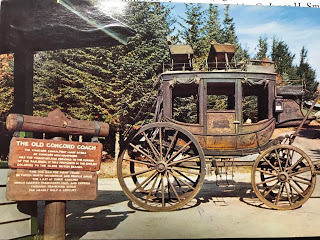
My husband Dave, who died in April, did enormous amounts of research for details I needed as I wrote my historical adventure novels set in North Upton (loosely based on North Danville), Vermont.
On September 1, 2019, I started writing the next book, tentatively titled O FIERCE AND KINDRED HEART. It will follow The Long Shadow (2018) and This Ardent Flame (accepted by the publisher, Five Star/Cengage; I am hoping for autumn 2020 publication). So this will be "Winds of Freedom" Book 3! And again it begins in North Upton, this time in 1854.
So of course, I went to Dave's stacks of postcards, and found right away this image of a Concord Coach: the kind of horse-drawn vehicle used to transport passengers and mail around New England and beyond. The card came from Franconia Notch, New Hampshire, mailed in 1961.
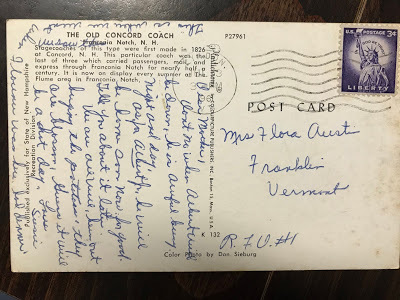
Notice the addressee? It's Flora Austin of Franklin, Vermont, and the sender is clearly her daughter or daughter-in-law, Susie. She starts by mentioning "Albert" and that she doesn't know when he'll be down, then says that Albert Jr. will soon be home for good.
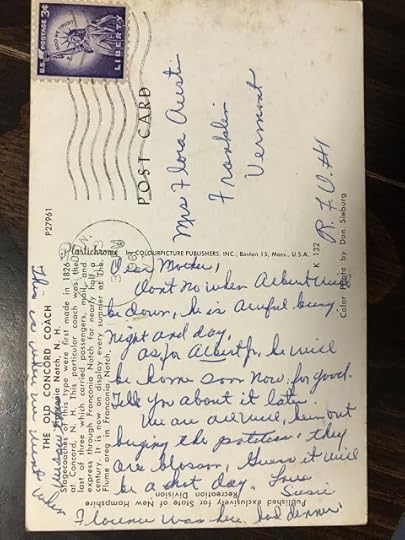 It's easier to read this way, right?
It's easier to read this way, right?Research, which Dave and I would have collaborated on after he'd identified the postcard publisher and probable photographer and photo year, becomes a chase for family details. And here's what I found:
Flora Bell (née Garrett) Austin was born about 30 September 1881 in Franklin, Vermont. She married Willard Charles Austin (born about 1861), and they show up in the 1940 Census. He was her second husband; her fist was Peter Chagnon (1863-1913), whom she married in 1897.
Flora's marriage to Willard bore a son Albert Willard Austin (1917-2000). His son, Flora's grandson (and either Susie's nephew or son), was Reginald Albert Austin -- presumably Albert Jr.
What fascinated me among the details is, this card's presence in the Northeast Kingdom was no accident: Willard Austin died in Lyndon on 29 April 1972, and although the recorded birthplace for Albert Willard Austin is Franklin, he died in St. Johnsbury, Vermont.
Those details make me wonder whether that the Austin family connected to this postcard may also connect to Lyndon's noted Dr. Venila Lovina Shores, whose paternal grandmother was an Austen (spelled with -en, not -in); could that be? It's the kind of coincidence that often arises when working with Northeast Kingdom history!
Meanwhile, I am content to know that the Concord Coaches once drove just a few miles from where I sit writing today -- and to find that "DK" was ahead of me, leaving more for me to investigate in his collection.
Published on September 15, 2019 18:31
August 16, 2019
Discussion Questions for THE LONG SHADOW
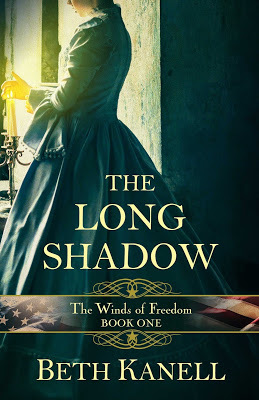 Even as teenager Alice Sanborn begins to question the boundaries of life in her Vermont village of North Upton, her boldest actions come from taking seriously the "rules of life" she's grown up with: education, friendship, moral imperatives like correcting evil, and of course working together to make life reasonably comfortable through four seasons. Vermont winter is a force to reckon with! Consider Alice's experience as she rides up Sheffield Heights in a March blizzard:
Even as teenager Alice Sanborn begins to question the boundaries of life in her Vermont village of North Upton, her boldest actions come from taking seriously the "rules of life" she's grown up with: education, friendship, moral imperatives like correcting evil, and of course working together to make life reasonably comfortable through four seasons. Vermont winter is a force to reckon with! Consider Alice's experience as she rides up Sheffield Heights in a March blizzard:As the sleigh tilted sideways, I found my wits and scrambled out of my side of it, struggling to pull downward and keep it from completely capsizing. Sarah and Jerushah clung to the back of it, crying out. So much noise and commotion—perhaps it helped to keep the invisible animal in front of us from coming closer. Its growl rose in volume, however, and the horse reared onto its hind legs. Solomon still clung to the bridle. I grabbed Sarah and pulled her free from the sleigh, and Jerushah scrambled out, just before it capsized fully into the snowbank at the left side of the road. The horse managed to come down in a half turn, dragging the capsized sleigh back the way we’d come. Solomon yelled and swore. One of his legs, caught in the leather straps of the reins and harness, jerked him so hard that he let go of the horse’s head at last and fell, yelping with pain as his shoulders struck the roadway. But I had eyes only for what stood revealed in front of us, a dead lamb dangling from its jaws, and the crescendo of its growl rising into a high-pitched threat: wild-eyed face suddenly visible in a gap in the snowfall, legs tensed to leap, body easily three feet long and muscular, and the long tail slashing back and forth behind it. A catamount. The fierce and powerful beast of the mountains stared at the three of us as we clung to each other, unable to think beyond the screams that erupted from all of us at once.Here are some issues to consider after reading the book:
Would you want Alice for a friend yourself? Why or why not?How different are the roles of teen boys and girls in the 1850s? In what ways does Alice fit the expectations -- and how does she push back against them?The "Underground Railroad" is an exciting part of American history -- but it doesn't fit well into Alice's experience in Vermont. Name three things that show why Vermont in the 1850s had an "aboveground railroad" for dark-skinned people traveling north.Readers often groan at the amount of work Alice does, just to get through an ordinary day. Which tasks surprised you? How has daily life changed so that you are not doing those tasks?Alice, like her neighbors in the village, sees slave-holding as a sin against man and God. A decade after THE LONG SHADOW, a "war between brothers" will split America around this issue. Problems that remain in today's America would be, for Alice, part of the "wages of sin." Do you agree? Give examples of some of these problems.Curious about a detail or can't decide about an issue? This Vermont author makes book-group visits, in person, via email, and via Skype or FaceTime. Get in touch!
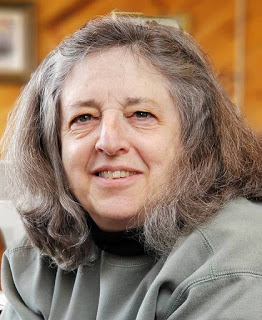
Published on August 16, 2019 11:19



